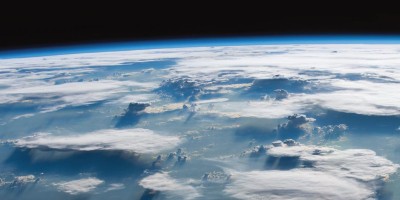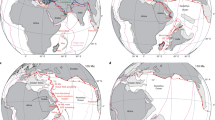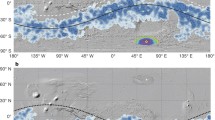Abstract
The two most striking surface features on Mars are the Tharsis Rise and the crustal dichotomy1,2. The crustal dichotomy, an elevation difference of ∼5 km between the southern highlands and the northern lowlands, is the oldest geological feature on Mars, and the Tharsis Rise is a vast volcanic construct in the equatorial region of the planet, near the dichotomy boundary. Tharsis volcanism was initiated in the southern highlands and the main volcanic centre subsequently migrated to its current location3,4,5, suggesting relative motion between the lithosphere and the underlying mantle. However, as a one-plate planet, Mars cannot have large-scale motion of the lithosphere according to the standard theory of stagnant-lid convection6,7. Here I use three-dimensional spherical shell models of mantle convection to demonstrate that a unique mode of horizontal motion of the lithosphere, differential rotation, is readily excited for Mars by one-plume convection and lithospheric thickness variations. The suggested mechanism explains the temporal and spatial patterns of Tharsis volcanism and offers a path to a unified model for Tharsis rise and the crustal dichotomy, with implications for volcanism, tectonics and true polar wander on other one-plate planetary bodies.




Similar content being viewed by others
References
Solomon, S. C. et al. New perspectives on ancient Mars. Science 307, 1214–1220 (2005).
Nimmo, F. & Tanaka, K. Early crustal evolution of Mars. Annu. Rev. Earth Planet. Sci. 33, 133–161 (2005).
Frey, H. V. Thaumasia: A fossilized early forming Tharsis uplift. J. Geophys. Res. 84, 1009–1023 (1979).
Mege, D. & Masson, P. A plume tectonics model for the Tharsis province, Mars. Planet. Space Sci. 44, 1499–1546 (1996).
Johnson, C. L. & Phillips, R. J. Evolution of the Tharsis regions of Mars: Insights from magnetic field observations. Earth Planet. Sci. Lett. 230, 241–254 (2005).
Head, J. W. & Solomon, S. C. Tectonic evolution of the terrestrial planets. Science 213, 62–76 (1981).
Solomatov, V. S. Scaling of temperature- and stress-dependent viscosity convection. Phys. Fluids 7, 266–274 (1995).
Frey, H. Impact constraints on, and a chronology for, major events in early Mars history. J. Geophys. Res. 111, E08S91 (2006).
Zuber, M. T. et al. Internal structure and early thermal evolution of Mars from Mars Global Surveyor topography and gravity. Science 287, 1788–1793.
Andrews-Hanna, J. C., Zuber, M. T. & Banerdt, W. B. The Borealis basin and the origin of the martian crustal dichotomy. Nature 453, 1212–1215 (2008).
Nimmo, F., Hart, S. D., Korycansky, D. G. & Agnor, C. B. Implications of an impact origin for the martian hemispheric dichotomy. Nature 453, 1220–1224 (2008).
Zhong, S. J. & Zuber, M. T. Degree-1 mantle convection and the crustal dichotomy on Mars. Earth Planet. Sci. Lett. 189, 75–84 (2001).
Elkins-Tanton, L., Parmentier, E. M. & Hess, P. Possible formation of ancient crust on Mars through magma ocean processes. J. Geophys. Res. 110, E12S01 (2005).
Ke, Y. & Solomatov, V. S. Early transient superplumes and the origin of the Martian crustal dichotomy. J. Geophys. Res. 110, E10001 (2006).
Roberts, J. H. & Zhong, S. J. Degree-1 convection in the Martian mantle and the origin of the hemispheric dichotomy. J. Geophys. Res. 111, E06013 (2006).
Phillips, R. J. et al. Ancient geodynamics and global-scale hydrology on Mars. Science 291, 2587–2591 (2001).
Kiefer, W. S. Shergottite formation and implications for present-day Mantle convection on Mars. Meteorit. Planet. Sci. 38, 1815–1832 (2003).
Harder, H. & Christensen, U. R. A one-plume model of Martian mantle convection. Nature 380, 507–509 (1996).
Hager, B. H. & O’Connell, R. J. A simple global model of plate dynamics and mantle convection. J. Geophys. Res. 86, 4843–4867 (1981).
Zhong, S. J. Role of ocean-continent contrast and continental keels on plate motion, net rotation of lithosphere and the geoid. J. Geophys. Res. 106, 703–712 (2001).
McNamara, A. K. & Zhong, S. J. Thermochemical structures within a spherical mantle: Superplumes or piles? J. Geophys. Res. 109, B07402 (2004).
Neumann, G. A. et al. Crustal structure of Mars from gravity and topography. J. Geophys. Res. 109, E08002 (2004).
Pollack, H. N. Cratonization and thermal evolution of the mantle. Earth Planet. Sci. Lett. 80, 175–182 (1986).
King, S. D. Archean cratons and mantle dynamics. Earth Planet. Sci. Lett. 234, 1–14 (2005).
Nimmo, F. Tectonic consequences of Martian dichotomy modification by lower crustal flow and erosion. Geology 33, 533–5361 (2005).
Wenzel, M. J., Manga, M. & Jellinek, A. M. Tharsis as a consequence of Mars’ dichotomy and layered mantle. Geophys. Res. Lett. 31, L04702 (2004).
Wullner, U. & Harder, H. Convection underneath a crust inhomogeneously enriched heat sources: Application to Martian mantle dynamics. Phys. Earth Planet. Inter. 109, 129–150 (1998).
Stanley, S., Elkins-Tanton, L., Zuber, M. T. & Parmentier, E. M. Mars’ paleomagnetic field as the result of a single-hemisphere dynamo. Science 321, 1822–1825 (2008).
Redmond, H. L. & King, S. D. The crustal dichotomy and edge driven convection: A mechanism for tharsis rise volcanism? Lunar Planet. Sci. Conf. XXXVI 1960 (abstr.) (2005).
Perron, J. T., Mitrovica, J. X., Manga, M., Matsuyama, I. & Richards, M. A. Evidence for an ancient martian ocean in the topography of deformed shorelines. Nature 447, 840–843 (2007).
Matsuyama, I., Nimmo, F. & Mitrovica, J. X. Reorientation of planets with lithospheres: The effect of elastic energy. Icarus 191, 401–412 (2007).
Acknowledgements
The author would like to thank F. Nimmo for discussions on TPW and S. King for reviewing the manuscript. This work is supported by the NASA MFR programme and the David and Lucile Packard Foundation. CIG distributes the software CitcomS that is used in this study.
Author information
Authors and Affiliations
Corresponding author
Supplementary information
Supplementary Information, Table S1
Supplementary Information (PDF 357 kb)
Rights and permissions
About this article
Cite this article
Zhong, S. Migration of Tharsis volcanism on Mars caused by differential rotation of the lithosphere. Nature Geosci 2, 19–23 (2009). https://doi.org/10.1038/ngeo392
Received:
Accepted:
Published:
Issue Date:
DOI: https://doi.org/10.1038/ngeo392
- Springer Nature Limited
This article is cited by
-
The Tharsis mantle source of depleted shergottites revealed by 90 million impact craters
Nature Communications (2021)
-
Pre-mission InSights on the Interior of Mars
Space Science Reviews (2019)
-
Mars: a small terrestrial planet
The Astronomy and Astrophysics Review (2016)
-
Long-Term Evolution of the Martian Crust-Mantle System
Space Science Reviews (2013)
-
Hotspots leave magnetic scars on Mars
Nature (2010)





